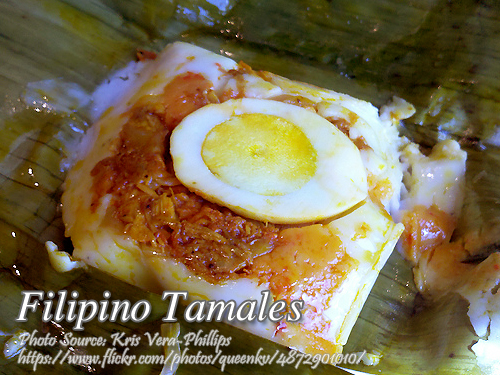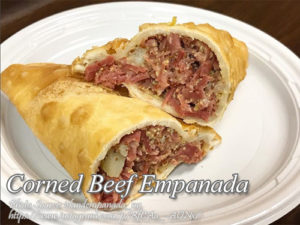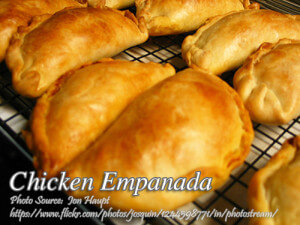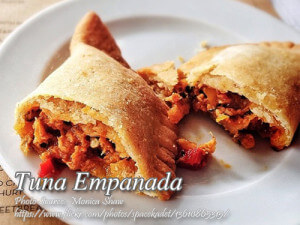Tamales, originally is a Mexican delicacy made from corn masa (a finely ground corn flour made into a dough) with chicken, pork or beef wrap in corn husk or banana leaves. Our local version is made out of rice, coconut milk, sugar, pork, chicken meat, boiled eggs and sausage then wrapped in banana leaves. This recipe is a Filipino version of tamales. Well known in Cavite and also in Pampangga.
A Nostalgic Taste of Filipino Tamales
But I remember that the first time that I was able to taste our family’s take on tamales. It was during a small party in Cavite, where my uncle Ernesto proudly brought out a tray he called “our family’s heirloom recipe.” Suddenly, the smell of coconut milk and rice resonated well into my childhood holidays spent with my lola. Though tamales have become renowned all over the world as a Mexican dish, our local version has various tastes and traditions, especially in provinces like Cavite and Pampanga, where it’s become a favorite delicacy.
Unlike its Mexican cousin which is composed of corn masa, wrapped in corn husks, our tamales are made of an entirely different main ingredient altogether-in this case, rice-flavored by coconut milk, achuete, and peanut butter-and wrapped in fragrant banana leaves. It is a dish carrying so much history, especially for many Filipino families where it takes a labor of love passed from generations to come.
From Cavite to Pampanga: A Regional Twist on Tamales
Although I am from Manila, most of the culinary heritage I received from my family is actually from Cavite, where tamales have been a staple for years. My auntie Lita, who has lived in Cavite longer than I have, taught me how to make this version. She swears by the process of toasting the rice until golden brown for that nutty aroma and deep flavour. Some families in Pampanga, she said make a slightly sweeter version by adding a touch more sugar while others focus on the rich savoriness brought by the pork and chicken.
In my family, it is always served during Christmas, but versatile enough to be made for any occasion: birthdays, fiestas, or simply when you want to indulge in a piece of home.
Doing with Love and Patience
What I’ve learned along the way, making it with my family throughout the years, is to be patient. The process can appear forbidding at first-the sheer numbers of layers you’re dealing with, say, from toasted rice to achuete-infused coconut cream-but trust me, the results are absolutely worth the effort.
First, you toast the rice until it’s golden brown then grind it fine. I remember my kuya Raul was always the volunteer for this part when we were younger, probably because he liked the rhythmic stirring of the rice in the pan. Then the ground rice is mixed with salt and pepper to season, forming the basis of your tamales.
Lastly, the coconut cream infused with achuete gives that orange vibrant coloring to the dish. My Lola always says that tamales are good when one continuously stirs this mixture over medium heat until it thickens. She would always remind us not to rush it; otherwise, the rice will not be able to absorb its flavor. Once the mixture thickens, you set aside some and mix it in with the peanut butter. It’s this peanut-buttery goodness that gives our version a twist among the rest of the Filipino tamales. It’s rich with another layer of savory flavor that complements how light and delicate the flavor of the rice is.
The Wrapping Process
Wrapping tamales is one of my favorite aspects of making them. There is something backwards-almost-nostalgic about the way the banana leaves are handled in the preparation, slightly wilted above an open flame to bend. I find myself transported back into another place, Sunday afternoons in the kitchen with mother and titas, laughing and telling stories as we folded each bunch carefully, one by one. In assembling each tamale, lay two spoonfuls of the rice mix on the banana leaves. Then, place the peanut butter mix, add slices of hard-boiled egg, flaked chicken, and strips of pork or sausage on top.
Wrapping them into neat squares, and then tied with strings, is practically more like a craft, a tradition so curried over generations. Each tamale is like its little bundle of joy, packed with flavors that remind me of home.
Steaming to Perfection
Now are already the time to cook all the tamales. My uncle Ernesto always insisted on using a big deep pan so that the tamales would be fully steamed in the boiling water. That’s how they can be sure that the rice inside would get the right amount of moisture so they will come out nicely soft yet firm. After a slow hour of steaming, you have a tamale of absolute texture.
But what I’ll always remember is the excitement of unwrapping each tamale and feeling the steam rise to dance outside our noses, accompanied by the intoxicating aroma of coconut and peanut butter. It’s a smell that takes me back instantly to childhood, to family gatherings, and to the joy of sharing meals with loved ones.
A Delicacy Born of History
This staple food is a staple in many a Filipino household; yet its history far stretches beyond our shores. And so, the tamales trace their origins back to the ancient Mesoamerican cultures where they were used as portable meals for warriors and hunters. During the colonization of the Philippines by the Spaniards, they brought their own culinary traditions but merged with it ingredients infused into the concept of the tamales. Then, our version would evolve into the dish that we know and love today, with rice as its base instead of corn.
Tamales in Cavite and Pampanga are mostly prepared for special occasions, but there is far much to them. They represent a mingling of Spanish and Filipino influences as well as the ingenuity of Filipino cooks who adapted the recipe to suit available flavors and ingredients locally.
A Taste of Home
It is about tradition, family, and richness in our culinary heritage-it’s more than just the recipe for making tamales. As I prepare this dish, I remember my auntie Lita’s kitchen in Cavite, my lola stirring with meticulous care, and Uncle Ernesto whom we consulted over the steaming tips. It’s a dish that brings people together, wrapped in familiar flavors.
Take that deep breath and enjoy the process the next time you are in the kitchen. Either you are doing tamales for the first time or passing this tradition to your little ones, remember that this dish carries many more stories and flavors than just the taste.
How to Cook Filipino Tamales
Ingredients
- 3 cups rice
- 5 cups coconut cream thin & thick together
- 2 Tbsp atchuete seeds
- 1 cup white sugar
- 3 tsp powdered pepper
- 4 Tbsp peanut butter
Topping:
- 1 cup flaked chicken meat cooked
- 2 hard boiled eggs
- 1 cup cooked pork sliced into strips or 3-4 Vienna Sausage (thin-round slices)
Instructions
How to cook Filipino Tamales:
- Toast rice until brown. Grind finely. Add salt and pepper. Set aside. Add achuete coloring to coconut cream. Boil in medium heat stirring constantly. Add powdered rice and sugar. Stir until well blended and thick.
- Separate 1/4 of cooked mixture and add to this the peanut butter. This mixture is for topping. For each tamales, put in 2-3 tablespoons of cooked mixture on two pieces of wilted banana leaves; top with 1 tablespoon peanut-butter mixture, 1-2 slices of hard-boiled egg, flaked chicken meat and strips of pork or sausage.
- Wrap to form a square and tie with a string. In a deep pan, put water enough to cover tamales. When water boils, put in tamales. Cover. Cook for 1 hour. Drain.
Notes
Cooking Tips:
Perfectly Toasting the Rice
Toasting the rice gives the dish its desired rich flavor, so stir constantly over medium heat, not letting the rice burn. When the rice goes to a light golden color, it is now ready for its grind in the tamale base.Getting the Right Consistency in Coconut Cream
Boiling the coconut cream with achuete requires one to be a very patient person as it needs constant stirring over medium heat because it can curdle and stick inside the pan. It should be thick enough to coat the back of the spoon.Wrapping Tamales Tidily
Wet the banana leaves slightly with an open flame or boiling water so that it will be easy to wrap. This way, you will not have tears in your tamales, which may result from cracking; this also allows for even cooking as they are well-packed. Secure them with strings to tighten them so that the filling won't run out during steaming.






The best tamales that I always tried to have in the philippines is a
made is San Juan Batangas. Is it possible to get this recipe from that place?. thank you. I believe it uses ground peanut mixed with toasted brown rice instead of peanut butter. thanks. I would appreciate your help.
Hi Elvira, I’ll try to find the recipe for you and post is as soon as I have it. Thanks for sharing your thoughts!
Hi I’d like to know ano ang size ng banana leaves to cut
Hi Adeline, about 8 x 8 inches of banana leaves.
Thank you for sharing this recipe. I really miss the filipino version of tamales. Can we use rice flour instead?
Hi Alelie, I think you can use rice flour.
Hello may I know what kind of peanut butter is good to use thanks
Hi, I think you can use any kind of peanut butter.
Hi Benjamin, thanks for the info. I corrected the post already.
Excellent article! But I have to correct you on one thing though, tamales ARE NOT a Spanish delicacy but a Meso American (Mexico -Central America). Maize or better known as corn was domesticated 10,000 years ago by indigenous peoples from Mexico and used tamales to transport food from place to place.
Thank you for sharing your recipie of tamales,but is it okay to use rice flour instead of regular rice?
Kapampangan tamales don’t have sugar. Kapampangan tamales are not sweet.
ooppss, i meant to ask: what’s the measurement of the salt and powdered rice?
thanks again,
josie
@Josie
the powdered rice is the 3 cups rice which is toasted and grounded. The salt depends on your taste.
thanks for publishing this recipe, but am I missing some ingredients? The recipe called for salt and powdered rice, but they are not mentioned in the ingredients. So, much much salt and powdered rice do I need?
Thank,
josie
I thank you so much for sharing your recipe with me. I really love our Filipino Tamales. When I was young in Pampanga my late grandpa used to buy me Tamale that he called “Botu-botu” for my breakfast. I really like the thicker Tamale. Until now, they are my favorites. I can eat 3 at the same time. However, I always eat only a maximum of two. I always say, “JOhn na pa!”
Thanks a lot!
what’s the use of 2 cups of white sugar?